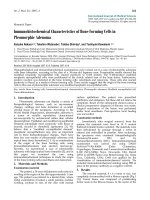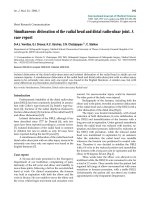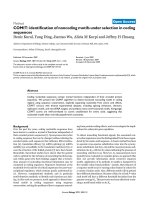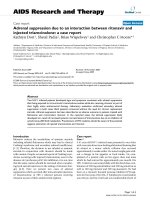Báo cáo y học: " Immunohistochemical identification of primary peritoneal serous cystadenocarcinoma mimicking advanced colorectal carcinoma: a case report." docx
Bạn đang xem bản rút gọn của tài liệu. Xem và tải ngay bản đầy đủ của tài liệu tại đây (1.15 MB, 5 trang )
BioMed Central
Page 1 of 5
(page number not for citation purposes)
Journal of Medical Case Reports
Open Access
Case report
Immunohistochemical identification of primary peritoneal serous
cystadenocarcinoma mimicking advanced colorectal carcinoma: a
case report
Wesley B von Riedenauer*
1
, Sumbul A Janjua
1,3
, David S Kwon
1
,
Ziying Zhang
2
and Vic Velanovich
1
Address:
1
Department of Surgery, Henry Ford Hospital, Detroit, Michigan, USA,
2
Department of Pathology, Henry Ford Hospital, Detroit,
Michigan, USA and
3
The Aga Khan University Medical College, Karachi, Pakistan
Email: Wesley B von Riedenauer* - ; Sumbul A Janjua - ;
David S Kwon - ; Ziying Zhang - ; Vic Velanovich -
* Corresponding author
Abstract
Primary peritoneal cystadenocarcinoma is a rare tumor of similar histogenic origin as primary
ovarian carcinoma. We present a case of primary peritoneal serous cystadenocarcinoma mimicking
advanced colorectal cancer in a 68 yr-old African American female. Radiology, endoscopy and
cytology yielded only inconclusive findings. Immunohistochemical analysis of percutaneously
obtained ascitic fluid provided a correct diagnosis of primary peritoneal cystadenocarcinoma. The
discovery of serous ascites at the time of laparotomy confirmed a diagnosis of primary peritoneal
serous cystadenocarcinoma. Final surgical pathology reconfirmed the diagnosis of primary
peritoneal cystadenocarcinoma. This case demonstrates the utility of immunohistochemistry for
accurately diagnosing patients with inconclusive findings in the setting of peritoneal carcinomatosis
and primary peritoneal cystadenocarcinoma.
Introduction
Primary peritoneal cystadenocarcinoma is a rare tumor
[1]. Originally described by Swerdlow in 1959, the true
incidence of primary peritoneal cystadenocarcinoma
remains unknown although an estimated relative fre-
quency to ovarian cancer is 1:10[2]. Better recognition of
this entity in recent years has contributed to an increasing
diagnostic frequency approaching 18% of laparotomies
performed for ovarian carcinoma [2]. Synonyms for pri-
mary peritoneal cystadenocarcinoma include primary
peritoneal papillary carcinoma, extraovarian peritoneal
papillary carcinoma, peritoneal mesothelioma, surface
papillary carcinoma, primary peritoneal carcinoma, and
multiple focal extraovarian carcinoma [1]. Primary ovar-
ian carcinoma may present as a solitary mass, but is the
most common cause of carcinomatosis in women. Pri-
mary peritoneal cystadenocarcinoma uniformly presents
as disseminated intraperitoneal carcinomatosis.
Both primary ovarian carcinoma and primary peritoneal
cystadenocarcinoma can present with carcinomatosis.
Clinical presentation results from local tumor effects
involving multiple organs [3]. Common symptoms
include abdominal distension/ascites, dyspnea, nausea,
vomiting and constipation. The most common presenting
complaints are ascites, abdominal mass and pleural effu-
sion. Both primary ovarian carcinoma and primary perito-
neal cystadenocarcinoma have serous and mucinous
Published: 26 November 2007
Journal of Medical Case Reports 2007, 1:150 doi:10.1186/1752-1947-1-150
Received: 24 June 2007
Accepted: 26 November 2007
This article is available from: />© 2007 von Riedenauer et al; licensee BioMed Central Ltd.
This is an Open Access article distributed under the terms of the Creative Commons Attribution License ( />),
which permits unrestricted use, distribution, and reproduction in any medium, provided the original work is properly cited.
Journal of Medical Case Reports 2007, 1:150 />Page 2 of 5
(page number not for citation purposes)
subtypes. The serous subtypes, primary serous ovarian car-
cinoma and primary peritoneal serous cystadenocarci-
noma, predominate over the mucinous subtypes in both
primary ovarian carcinoma and primary peritoneal cysta-
denocarcinoma. Ascites and abdominal distension appear
more frequently with primary peritoneal cystadenocarci-
noma than with primary ovarian carcinoma. Primary
ovarian carcinoma alternately presents more often with a
palpable pelvic mass. Primary peritoneal cystadenocarci-
noma and primary ovarian carcinoma are immunohisto-
chemically indistinguishable [1,4]. Both malignancies
stain positive for CK7, ER, Mesothelin and CA125. Pri-
mary peritoneal cystadenocarcinoma is histologically dis-
tinguished from primary ovarian carcinoma by ovaries of
normal size or enlarged secondary to a benign process,
extraovarian involvement greater than ovarian involve-
ment, and ovarian surface penetration of less than 5 mm
depth [1,3,4].
Management of primary peritoneal cystadenocarcinoma
has followed treatment of primary ovarian carcinoma
with surgical debulking and adjuvant platinum-contain-
ing chemotherapy [4]. Survival in primary peritoneal
serous cystadenocarcinoma parallels survival of stage III–
IV primary serous ovarian carcinoma [1,4,5]. Median sur-
vivals for primary peritoneal serous cystadenocarcinoma
and primary serous ovarian carcinoma are equivalent and
range from 32–40 months [1,5].
Primary peritoneal cystadenocarcinoma and primary
ovarian carcinoma both stain positive for estrogen recep-
tor (ER), cytokeratin 7 (CK7), Wilm's tumor suppressor
gene (WT1), and cancer antigen 125 (CA 125). Neither
entity possesses cytokeratin 20 (CK 20), progesterone
receptor (PR), Calretinin, carcinoembryonic antigen
(CEA), gross cystic disease fluid protein (BRST-2), and
thyroid transcription factor 1 (TTF1). Cytochemical over-
lap can occur between different celltypes but the constel-
lation of positive and negative antigenicity produces a
unique immunohistochemical "fingerprint" that identi-
fies cellular origin.
Case presentation
The patient was a 68 yr-old African American female who
presented to the emergency department of Henry Ford
Hospital with complaints of shortness of breath and
abdominal distension. Her past medical history was sig-
nificant for asthma, Type II diabetes mellitus, hyperten-
sion, gastroesophageal reflux, adenomatous colonic
polyps and breast cancer. Abdominal ascites and a right
pleural effusion were present. Ultrasound imaging (US) of
the abdomen and pelvis was normal except for the known
ascites. Computed tomography (CT) of the abdomen and
pelvis demonstrated moderate ascites, a right pleural effu-
sion and omental thickening. US and CT imaging failed to
demonstrate any masses. Magnetic resonance imaging of
the abdomen and pelvis revealed pelvic peritoneal masses
suspicious for metastatic implants and a 4.1 centimeters
mass in the appendix. Colonoscopy was performed to the
cecum. At 50 centimeters proximal to the anal verge, a 4
centimeters subserosal non-circumferential partially
occluding mass was discovered. The mass was biopsied.
The remainder of the exam was normal. Consideration
was given to an endoscopically concealed appendiceal
cystadenocarcinoma or primary appendiceal colonic ade-
nocarcinoma. Pathology reported the endoscopic tissue
biopsy as displaying a moderately well differentiated ade-
nocarcinoma with a papillary growth pattern (Fig. 1).
Attendant paracentesis was performed and the ascitic fluid
obtained was positive for malignant cells consistent with
metastatic adenocarcinoma. Immunohistochemical stain-
ing of the malignant ascitic cells was positive for CA 125,
WT-1, CK7 and ER but negative for CK20, TTF-1, PR, Cal-
retinin and BRST-2. These immunohistochemistry results
were consistent with primary peritoneal cystadenocarci-
noma or primary serous ovarian carcinoma. Ovarian ori-
gin was believed very unlikely without radiologic
evidence of a pelvic mass. The gynecologic oncology serv-
ice concurred that the probability of a primary ovarian ori-
gin was remote. Primary peritoneal cystadenocarcinoma
became the operating diagnosis. Surgical consultation was
requested.
Exploratory laparotomy was offered and performed. Pen-
etration of the peritoneum immediately presented serous
ascites. The omentum was grossly thickened and adherent
to the mid transverse colon at 50 centimeters proximal to
the anus. This section of transverse colon was segmentally
H & E section of sigmoid colonic mucosal biopsy demonstrat-ing nests of infiltrating neoplastic glands with a papillary growth patternFigure 1
H & E section of sigmoid colonic mucosal biopsy demonstrat-
ing nests of infiltrating neoplastic glands with a papillary
growth pattern.
Journal of Medical Case Reports 2007, 1:150 />Page 3 of 5
(page number not for citation purposes)
excised (Fig. 2). Multiple areas of peritoneal studding sig-
nificantly involved the small bowel gutter and ascending
colon. Foreshortening of the cecal mesentery was noted in
conjunction with a soft verrucous appendix. Effective
debulking mandated a right hemicolectomy, which was
performed. Intestinal continuity was re-established with a
standard side-to-side ileocolostomy. Histologic evalua-
tion of the submitted omentum and transverse colon
specimen revealed a moderately differentiated adenocar-
cinoma with an infiltrative papillary growth pattern char-
acteristic of primary peritoneal cystadenocarcinoma (Fig.
3). Histologic findings in the surgical and endoscopic
biopsy specimens were analogous and confirmed primary
peritoneal cystadenocarcinoma. These histologic findings
also substantiated the immunohistochemical diagnosis of
primary peritoneal cystadenocarcinoma. Postoperative
ileus complicated the patient's recovery. She was dis-
charged to home tolerating a regular diet on postoperative
day 8. Systemic chemotherapy with carboplatin and Taxol
was arranged in follow-up.
Discussion
The patient presented with a diagnosis of metastatic ade-
nocarcinoma of the colon. Her personal history of colonic
polyps and her strong family history of colon cancer sup-
ported this diagnosis. Endoscopic and pathologic findings
were inconsistent with advanced colorectal cancer. Radio-
logic imaging demonstrated peritoneal carcinomatosis
but could not identify a unique origin. Accurately identi-
fying the origin of the patient's peritoneal carcinomatosis
predicated appropriate therapy as treatment differs
among the varying malignancies causing peritoneal carci-
nomatosis. Disease progression and survival also differ
among the varying malignancies causing peritoneal carci-
nomatosis and correct identification of malignant origin
was required for accurate prognosis.
Breast and gastrointestinal metastasis may clinically, radi-
ologically and biochemically mimic primary ovarian and
primary peritoneal adenocarcinoma [6]. Peritoneal mes-
othelioma and pulmonary malignancies can also present
clinically similar to primary ovarian carcinoma and pri-
mary peritoneal cystadenocarcinoma with abdominal
pain and ascitic distension. Treatment of primary perito-
neal mesothelioma and carcinomatosis from metastatic
breast, lung and gastrointestinal cancers differ signifi-
cantly from the treatment of primary ovarian and primary
peritoneal adenocarcinoma. Surgical debulking with
intraoperative hyperthermic chemotherapy provides
some survival advantage with peritoneal mesothelioma
[7]. Advanced peritoneal mesothelioma is treated with
combination systemic chemotherapy [7]. Overall survival
with peritoneal mesothelioma is less than twelve months
[7]. Peritoneal carcinomatosis resulting from colorectal
primaries has also been treated with intraoperative hyper-
thermic chemotherapy an surgical debulking [8]. Survival
in patients with peritoneal carcinomatosis from colorectal
H & E section of omentum showing diffuse infiltration by tumor cellsFigure 3
H & E section of omentum showing diffuse infiltration by
tumor cells. The tumor cells demonstrate the papillary
growth pattern characteristic of primary peritoneal adeno-
carcinoma.
Gross picture of a segment of transverse colon with attached omentumFigure 2
Gross picture of a segment of transverse colon with attached
omentum. The Omentum is firm, nodular, and totally
replaced by tumor.
Journal of Medical Case Reports 2007, 1:150 />Page 4 of 5
(page number not for citation purposes)
primaries varies from 5.3 to 12.6 month [8]. Systemic
chemotherapy for peritoneal carcinomatosis resulting
from advanced colorectal cancer is 5-fluorouracil (5-FU)
based with the addition of Oxaliplatin, Irinotecan, Bevaci-
zumab, and Cetuximab based on the patient's perform-
ance status and whether prior chemotherapy was
provided [9]. Median survival for peritoneal carcinomato-
sis secondary to disseminated pulmonary malignancies is
2 months [10]. Surgical intervention with breast cancer
carcinomatosis shows a variable survival advantage [11].
Chemotherapy and hormonal manipulation prolongs
survival with breast cancer carcinomatosis [11]. Cytore-
ductive surgery combined with systemic cisplatin-based
multiagent chemotherapy extends survival in both pri-
mary ovarian and primary peritoneal cystadenocarcinoma
[1]. Survival with carcinomatosis secondary to primary
ovarian carcinoma and primary peritoneal cystadenocar-
cinoma can extend beyond thirty months [1].
Metastatic lung cancer and peritoneal mesothelioma were
excluded based on the absence of pulmonary disease on
radiologic imaging and the absence of characteristic his-
topathologic features on biopsy, respectively. The patient
reported a personal history of breast cancer, ductal carci-
noma in situ, treated with lumpectomy and radiation ther-
apy five years prior. Surgical margins were negative.
Tamoxifen was prescribed following completion of her
radiation therapy, but was discontinued after one month.
This history of breast cancer raised our suspicion of a
breast origin. Metastatic breast cancer was considered
unlikely given the rarity of peritoneal carcinomatosis from
this disease in the absence of any other evidence of metas-
tasis. Primary ovarian carcinoma was considered given the
patient's personal history of breast cancer. Genetic testing
was not performed. Consultation with the gynecologic
oncology service disavowed a primary ovarian etiology.
The possibility of primary peritoneal adenocarcinoma
became prescient.
Immunohistochemical analysis lead to the correct identi-
fication of primary peritoneal cystadenocarcinoma while
excluding alternate diagnoses. Tumor markers ordered
included: CK7, CK20, TTF1, ER, PR, Calretinin, WT1, CA
125, BRST-2, and CEA. Colon adenocarcinoma stains pos-
itive for CK20 and typically negative for CK7, CA125,
TTF1 and ER. Breast cancer cells typically stain positive for
CK7, ER and are negative for CA125, CK20, and TTF1.
Ovarian carcinoma binds antigens for CK7, CA125, ER,
and is negative for CDX2, CK20, and TTF1. The patient's
cells were immunohistochemically negative for CK20,
TTF1, Calretinin, PR and BRST-2. Her immunohistochem-
istry was positive for CA125, WT1, CK7, and ER. Primary
peritoneal cystadenocarcinoma bears antigens CK7, ER,
WT1, and CA125. The constellation of symptoms, endo-
scopic morphology, imaging results, histo-pathologic and
immunohistochemical findings portrayed primary perito-
neal cystadenocarcinoma. Immunohistochemistry
allowed the patient to be diagnosed without surgery.
Without immunohistochemical technology, patients with
diagnostically uncertain peritoneal carcinomatosis for-
merly required open or laparoscopic tissue biopsy with
further operative interventions pending histologic analy-
sis. Immunohistochemistry facilitated diagnosis without
surgery.
Preoperatively discerning primary peritoneal serous cysta-
denocarcinoma from primary peritoneal mucinous aden-
ocarcinoma was not possible as these two entities are
indistinguishable immunohistochemically and histologi-
cally. Primary peritoneal serous cystadenocarcinoma was
confirmed by the intraoperative finding of clear ascites
and the patient was afforded significant tumor debulking.
Histo-pathology returned a diagnosis of moderately dif-
ferentiated invasive papillary adenocarcinoma, which was
consistent with primary peritoneal cystadenocarcinoma.
Our institution does not offer surgical debulking for peri-
toneal carcinomatosis secondary to advanced colorectal
cancer. Persistent misdiagnosis of advanced colorectal
cancer would have then resulted in suboptimal treatment
of this patient by forgoing surgical debulking and assign-
ing inappropriate chemotherapy.
Conclusion
Cognizance of primary peritoneal cystadenocarcinoma
and the utility of immunohistochemistry permitted the
accurate diagnosis of a patient previously misidentified as
having advanced colorectal adenocarcinoma. Correctly
diagnosing primary peritoneal cystadenocarcinoma dra-
matically affected this patient's prognosis as opposed to
metastatic colorectal adenocarcinoma with carcinomato-
sis. The incidence of primary peritoneal cystadenocarci-
noma has increased dramatically over the past 10 years
[2]. Perhaps the incident rise in primary peritoneal cysta-
denocarcinoma has resulted from a rising awareness of
this disease and an increased ability to pathologically dis-
tinguish this disease. With the known ability of gastroin-
testinal malignancies to mimic gynecologic cancer, and
with 1.1% of cancers referred to gynecologic oncologists
reported to be nongynecologic [12], the ability to distin-
guish advanced colorectal cancer from primary peritoneal
cystadenocarcinoma and primary ovarian carcinoma has
become more important. Immunohistochemical technol-
ogy demonstrated marked utility for distinguishing pri-
mary peritoneal cystadenocarcinoma from other
mimicking diseases in the setting of unknown primary
peritoneal carcinomatosis. This technology was successful
using only paracentesis and thus obviated the risks and
morbidity of surgical biopsy. Immunohistochemistry
facilitated preoperative diagnostic certainty and thereby
improved surgical planning. Improved patient outcomes
Publish with BioMed Central and every
scientist can read your work free of charge
"BioMed Central will be the most significant development for
disseminating the results of biomedical research in our lifetime."
Sir Paul Nurse, Cancer Research UK
Your research papers will be:
available free of charge to the entire biomedical community
peer reviewed and published immediately upon acceptance
cited in PubMed and archived on PubMed Central
yours — you keep the copyright
Submit your manuscript here:
/>BioMedcentral
Journal of Medical Case Reports 2007, 1:150 />Page 5 of 5
(page number not for citation purposes)
may result from further use of immunohistochemical
analysis to diagnose unknown primary peritoneal carci-
nomatosis.
Competing interests
The author(s) declare that they have no competing inter-
ests.
Authors' contributions
WV (Chief Resident/HOV) directly assembled patient
information, directed further in depth analysis of the
known literature, performed the operative interventions
and managed the recovery of the patient, reviewed and
directed several drafts of the manuscript, and was respon-
sible for the final construction of the manuscript for sub-
mission to the senior staff/primary investigator.
SJ (MSIV) acquired patient information, researched the
known literature, participated in the patient's surgery and
recovery, and constructed the manuscript under guidance.
In this capacity she directly contributed to the conceptual-
ization, design and production of this manuscript. Her
final manuscript was then submitted to senior members
for final approval.
DK (HOIII) acquired patient information, instructed the
junior investigator (SJ) in conceptualization and construc-
tion of the manuscript.
ZZ (Pathologist) processed, evaluated and diagnosed the
submitted surgical specimens. She also constructed the
pathology narrative for the final manuscript.
VV (Senior Staff) served as the senior staff reviewer/pri-
mary investigator on this case report. He initially con-
ceived the possibility of alternative diagnoses, arranged
patient testing, scheduled and immediately directed the
surgical interventions, supervised the patient's recovery
and follow-up. He was responsible for final approval of
the submitted manuscript following directed revision.
Consent
Written informed consent was obtained from the patient
for publication of the study.
Acknowledgements
No sources of funding were involved in the production of this manuscript
or the conduct of this study.
References
1. Bloss JD, Liao SY, Buller RE, et al.: Extraovarian peritoneal serous
papillary carcinoma: a case-control retrospective compari-
son to papillary adenocarcinoma of the ovary. Gynecol Oncol
1993, 50(3):347-351.
2. Halperin R, Zehavi S, Langer R, Hadas E, Bukovsky I, Schneider D: Pri-
mary peritoneal serous papillary carcinoma: a new epidemi-
ologic trend? A matched-case comparison with ovarian
serous papillary cancer. Int J Gynecol Cancer 2001, 11(5):403-408.
3. Piura B, Meirovitz M, Bartfeld M, Yanai-Inbar I, Cohen Y: Peritoneal
papillary serous carcinoma: study of 15 cases and compari-
son with stage III–IV ovarian papillary serous carcinoma. J
Surg Oncol 1998, 68(3):173-178.
4. McCluggage WG, Wilkinson N: Metastatic neoplasms involving
the ovary: a review with an emphasis on morphological and
immunohistochemical features. Histopathology 2005,
47(3):231-247.
5. Ben-Baruch G, Sivan E, Moran O, Rizel S, Menczer J, Seidman DS: Pri-
mary peritoneal serous papillary carcinoma: a study of 25
cases and comparison with stage III–IV ovarian papillary
serous carcinoma. Gynecol Oncol 1996, 60(3):393-396.
6. Hewitt MJ, Anderson K, Hall GD, et al.: Women with peritoneal
carcinomatosis of unknown origin: Efficacy of image-guided
biopsy to determine site-specific diagnosis. BJOG 2007,
114(1):46-50.
7. Sugarbaker PH, Yan TD, Stuart OA, Yoo D: Comprehensive man-
agement of diffuse malignant peritoneal mesothelioma. Eur
J Surg Oncol 2006, 32(6):686-691.
8. Koppe MJ, Boerman OC, Oyen WJ, Bleichrodt RP: Peritoneal car-
cinomatosis of colorectal origin: incidence and current treat-
ment strategies. Ann Surg 2006, 243(2):212-222.
9. National Comprehensive Cancer Network (NCCN), Clinical Practice Guide-
lines in Oncology; Colon Cancer & Rectal Cancer. Version 2 2007.
10. Satoh H, Ishikawa H, Yamashita YT, Kurishima K, Ohtsuka M, Seki-
zawa K:
Peritoneal carcinomatosis in lung cancer patients.
Oncol Rep 2001, 8(6):1305-1307.
11. Garg R, Zahurak ML, Trimble EL, Armstrong DK, Bristow RE:
Abdominal carcinomatosis in women with a history of breast
cancer. Gynecol Oncol 2005, 99(1):65-70.
12. Benoit MF, Hannigan EV, Smith RP, Smith ER, Byers LJ: Primary gas-
trointestinal cancers presenting as gynecologic malignan-
cies. Gyne Onc 2004, 95:388-392.









